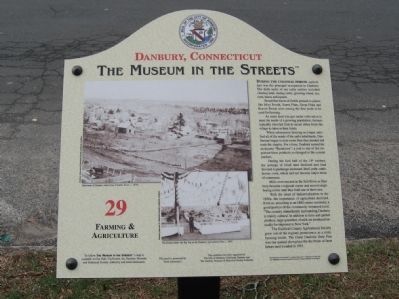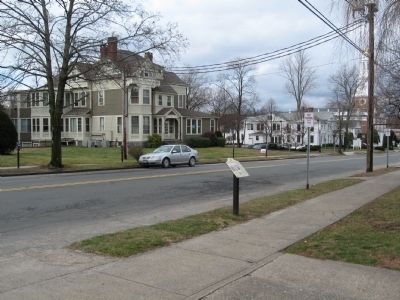Danbury in Fairfield County, Connecticut — The American Northeast (New England)
Farming & Agriculture
Danbury, Connecticut
— The Museum in the Streets® —
During the colonial period, agriculture was the principal occupation in Danbury. The daily tasks of our early settlers included clearing land, raising cattle, growing wheat, rye, corn, beans and squash.
Broad flat tracts of fertile ground in places like Miry Brook, Starrs Plain, Great Plain and Beaver Brook were among the first lands to be used for farming.
As more land was put under cultivation to meet the needs of a growing population, farmers typically traveled four to seven miles from the village to labor in their fields.
When subsistence farming no longer satisfied all the needs of the early inhabitants, Danburians began to raise more than they needed and trade the surplus. For a time, Danbury earned the nickname “Beantown”; a nod to one of the important farm products exchanged at the coastal markets.
During the first half of the 19th century, the acreage of tilled land declined and land devoted to pasturage increased. Beef, pork, cattle, horses, corn, wheat and rye became major items of commerce.
Mills were erected on the Still River as Danbury became a regional center and served neighboring towns until they built one of their own.
With the onset of industrialization in the 1850s, the importance of agriculture declined. Even so, according to an 1880 census summary, a good portion of the community remained rural. “The country immediately surrounding Danbury in mainly cultural. In addition to farm and garden produce, large quantities of milk are produced annually for shipment to New York.”
The Fairfield County Agricultural Society grew out of the regions prominence as a rural, farming locale. The Great Danbury State fair was our annual showplace for the fruits of farm labors until it ended in 1981.
Erected by The Museum in the Streets®. (Marker Number 29.)
Topics and series. This historical marker is listed in this topic list: Agriculture. In addition, it is included in the The Museum in the Streets®: Danbury, Connecticut series list. A significant historical year for this entry is 1880.
Location. 41° 23.442′ N, 73° 27.197′ W. Marker is in Danbury, Connecticut, in Fairfield County. Marker is at the intersection of Deer Hill Avenue and George Street, on the right when traveling north on Deer Hill Avenue. Touch for map. Marker is at or near this postal address: 149 Deer Hill Avenue, Danbury CT 06810, United States of America. Touch for directions.
Other nearby markers. At least 8 other markers are within walking distance of this marker. Inventions & Innovations (about 300 feet away, measured in a direct line); 19th & 20th Century Immigrants (about 400 feet away); Diversity in Danbury (about 400 feet away); Early Arrivals (about 400 feet away); Country Lanes & City Streets (about 600 feet away); Monumental Moments (about 700 feet away); The Sporting Life (about 800 feet away); Industrial Strength Danbury (approx. 0.2 miles away). Touch for a list and map of all markers in Danbury.
Credits. This page was last revised on November 25, 2021. It was originally submitted on January 19, 2014, by Michael Herrick of Southbury, Connecticut. This page has been viewed 486 times since then and 14 times this year. Photos: 1, 2. submitted on January 19, 2014, by Michael Herrick of Southbury, Connecticut.

